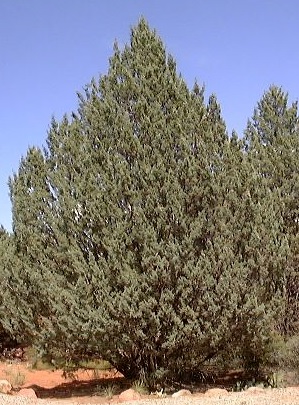 Arizona Cypress - September 11, 2013 Jeff Schalau, Agent, Agriculture & Natural Resources University of Arizona Cooperative Extension, Yavapai County Arizona Cypress (Cupressus arizonica) is an attractive evergreen tree well suited to elevations from 3,000 to 6,000 feet in Arizona (USDA Plant Hardiness Zones 6-9). These trees are part of the Sedona's native plant community and can be found next to intermittent streams and in cool canyons. During the Pleistocene Epoch, the desert southwest was much wetter and cooler than it is today. Arizona Cypress was widespread in the prehistoric southwest including the Salt and Gila River valleys. The distribution of Arizona Cypress began to diminish and fragment when the Pleistocene ice retreated northward about 10,000 years ago. We know this from pollen preserved in prehistoric packrat middens. Today, naturally occurring Arizona cypress clings to scattered sites in the southwest where the microclimate permits its survival and reproduction. Locally, these areas also include Pine, Payson, and the southern Bradshaw mountains. Arizona Cypress trees have been widely planted in Arizona landscapes. It is distinguished by its conical crown, smooth reddish bark, blue-green foliage, and small round cones. Arizona Cypress is a fast grower reaching up to 40 feet in height and spreading to 30 feet. In many areas of the Verde Valley, it is widely planted as a windbreak or to form a screen for privacy along fence lines. Several Arizona cypress cultivars have been developed and propagated to be more compact and pyramidal in shape. Ask a local nursery professional which cultivars they stock and their characteristics. Unfortunately, many native-grown and planted Arizona Cypress trees have died in recent years. A combination of factors led to these premature deaths. The droughts of 1996 and 2002-03 induced water stress on many native plants including Arizona Cypress. Following extended periods of drought, cypress bark beetles seized the opportunity to feed and reproduce on these trees. Cypress bark beetles are native insects that occur throughout Arizona. In addition to Arizona cypress, they use native juniper trees and Leyland Cypress as host species. They normally breed in limbs and trunks of weakened, broken, dying, or felled trees. When soil moisture is abundant, the 1/8" long beetle bores into a twig and kills the branch tip above the point of entry – usually a portion between 8 to 10 inches long. These dead branch tips remain hanging on the tree (called “flagging”) or fall to the ground below the tree. In severely drought-stressed trees, the beetles move from branch tips to colonize the trunk. Here, beetles chew vertical tunnels (galleries) between the bark and wood laying eggs along the way. The larvae hatch and tunnel outward destroying the phloem tissue that transports nutrients from the top downward usually killing the affected tree. Once bark beetles colonize the trunk of an Arizona cypress, little can be done to save the tree. So, you will need to provide supplemental irrigation to these trees. Irrigation is especially critical during May, June, July, or until the monsoon season is well under way. A simple way to irrigate any tree is with soaker hoses (porous black hose). During critical periods, irrigate deeply (two feet) twice a month in an area at least one and one-half the diameter of the drip line of the tree. Drip irrigation may be adequate during tree establishment, but as the tree grows, it becomes inadequate to support a larger tree. When trees are irrigated, the beetles may continue to "flag" the branch tips, but should not be successful at attacking the trunk. An irrigated Arizona Cypress stands a much greater chance of surviving bark beetle colonization during drought. Individual, high-value Arizona cypress trees can also be protected with appropriate insecticides prior to beetle colonization. This practice is also used to protect pine trees prior to bark beetle colonization. However, in my experience, periodic irrigation is adequate to maintain Arizona cypress tree vigor. Regular fertilizer applications are not recommended because this results in increased growth rates which require increased irrigation to support the additional growth. Fertilizer applications may be beneficial if specific nutrient deficiencies are noted. Planting a diverse mix of tree species can also decrease catastrophic pest problems. When one tree species predominates it creates a monoculture which can turn into an open invitation to pest attack. Look at additional resources below to learn more about Arizona cypress, cypress bark beetles, individual tree protection with insecticides, and prehistoric packrat middens. Follow the Backyard Gardener on Twitter – use the link on the BYG website. If you have other gardening questions, call the Master Gardener help line in the Camp Verde office at 928-554-8999 Ext. 3 or e-mail us at cottonwoodmg@yahoo.com and be sure to include your name, address and phone number. Find past Backyard Gardener columns or provide feedback at the Backyard Gardener web site: http://cals.arizona.edu/yavapai/anr/hort/byg/. Additional Resources Photos and Description of Arizona Cypress Yavapai County Native and Naturalized Plants http://cals.arizona.edu/yavapaiplants/SpeciesDetail.php?genus=Cupressus&species=arizonica Cypress Bark Beetles University of Arizona Cooperative Extension Publication #1316 http://cals.arizona.edu/pubs/insects/az1316.pdf Using Insecticides to Prevent Bark Beetle Attacks on Conifers University of Arizona Cooperative Extension Publication #1380 http://cals.arizona.edu/pubs/insects/az1380.pdf Packrat Midden USGS Colorado Plateau Research Station Publication http://sbsc.wr.usgs.gov/cprs/research/projects/global_change/middens.asp |